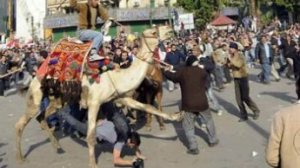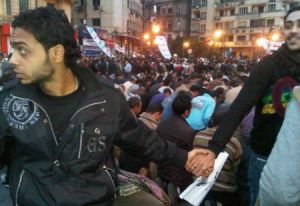February Timeline
1 February, Tuesday
In a televised address, Mubarak spoke to the Egyptians and announced he was willing to work on a peaceful transition of power but would not step down. He also stated that the constitution would be amended to limit the presidential terms and presidential candidacy terms.
2 February, Wednesday
Foreign journalists were attacked and harassed.
Pro-Mubarak forces attacked Tahrir on camels and horses, and blocked off access to Tahrir square.
3 February, Thursday
The protesters regained control of Tahrir square, but the pro-Mubarak forces continued to attack.
Omar Soliman, the vice president of Egypt, addressed the Egyptian people saying that the revolution, “goes against our culture, we always respect our president, respect our father, respect the guy who has done well for his country as president Mubarak has done.” He also stated that the protests would be resolved without violence, there would be reforms to the constitution, and Egypt would not end up like Tunisia.
4 February, Friday
Called the “Day of Departure” protests, protesters gathered in Tahrir square to protests for Mubarak to step down from power. Christian protesters guarded Muslim protesters as they prayed.
5 February, Saturday
Protests leaders met with Omar Soliman to discuss the transition of power and their demands.
Mubarak resigned as leader of the National Democratic Party (NDP), but not the presidency.
6 February, Sunday
International news reporters were attacked after state media broadcast claims that foreigners were destroying Egypt.
Protesters Ola Abdel Hamid and Ahmed Zaafan were married in Tahrir Square.
8 February, Tuesday
Wikileaks released documents revealing that the Israeli government was very comfortable with Omar Soliman taking over the presidency, as the Israeli government believed it could count on him not to repudiate the peace treaties.
Mass strikes occurred at the Suez Canal, protesters demanding higher wages, and better health benefits and working conditions.
Protests in New Valley, Egypt were violently put down.
10 February, Thursday
Mubarak gave a speech promising a peaceful and gradual transition of power, and said he had no intention of leaving his position before September.
Mohamed ElBaradei published an op-ed in the New York Times outlining his goals for the Egyptian people. He stated that the Egyptian people had been repressed too long and that their desire could no longer be contained. Long term, ElBaradei said Egypt could become an example of peace, stability and freedom in the Middle East. He outlined a plan for a “peaceful orderly transition of power,” by dissolving the Parliament, replacing the current constitution with a provisional constitution created by a three person council including a representative from the military.
11 February, Friday
Mubarak stepped down, handing power over to a council of military leaders (SCAF). People celebrated around the world.
The Supreme Council of the Armed Forces (SCAF) issued three statements, stating that they would respect the people and protect them, end the emergency law, guarantee changes and reforms that Mubarak promised, called for free and fair elections, asked the people to return back to normal life and finally the army accepted the responsibility of rule, and saluted the martyrs that died in the protests.
Laura Logan, a CBS Chief Foreign Correspondent was separated from her entourage during the celebrations of Mubarak’s resignation, and was sexually assaulted and beaten.
12 February, Saturday
SCAF issued another statement saying that everyone had responsibilities to their country, the military interim government would rule until elections, and they will guarantee a peaceful transition of power. The council asked the people to cooperate with police, and stated that Egypt would honor its international treaties.
13 February, Sunday
SCAF stated its goals included a freer constitution and army rule for only six months, and once again reassured the world that Egypt would respect international treaties.
SCAF dissolved the parliament. Field Marshal Mohamed Hussein Tantawy, head of the council, became de facto head of the government, while Ahmed Shafiq continues as Prime Minister.
18 February, Friday
The Armed Forces Council created a Facebook page
23 February, Wednesday
The official interim cabinet member list was released:
- Dr. Yahia El Gamal as deputy prime minister
- Dr. Amr Ezz as minister of scientific research and technology
- Dr. Ahmed Gamal El-Din as minister of higher education and education
- Dr. Maged Ibrahim Othamn as minister of telecommunication and IT
- Dr. Ashraf Hatem as minister of health and population
- Eng. Mahmoud Amar as minister of oil and minerals wealth
- Dr. Gouda Abdel Khalak as minister of social security
- Dr. Samir Youssef as minister of trade and industry
- MR. Ismail Fahmy as minister of manpower and immigration
- MR. Mounir Fakhri Abdel Nour as minister of tourism
- Eng. Mohamed El-Sawy as minister of culture
24 February, Thursday
25 February, Friday
26 February, Saturday
27 February, Sunday
Protesters renamed the Mubarak metro station “Martyrs of January 25th station.”
The Governor of Qalyubia, Adly Hussein, resigned due to public pressure and because of his affiliation with the NDP.
